Results 8,401 to 8,410 of 12096
Thread: Anandtech News
-
07-20-18, 11:39 AM #8401
Anandtech: HP Unveils Z2 Mini G4 SFF Workstations: Up to Six-Core Xeons, Pro GPUs
HP this week upgraded its miniature Z2 Mini workstation with the latest Intel’s Core and Xeon E processors with up to six cores as well as professional-grade graphics cards from AMD or NVIDIA. The HP Z2 Mini G4 machines sustained a very compact form-factor of the previous-gen Z2 Mini systems, but significantly improved performance over the models launched more than 1.5 years ago.
The fourth-generation HP Z2 Mini workstations come in a black chassis made of a metal alloy and featuring a some plastic parts. The box measures 216×216×58 mm (8.5×8.5×2.28 inches), which is larger than consumer-grade Intel’s NUCs (and their derivatives from other brands), but is smaller than typical gaming systems with discrete GPUs. Miniature size is of course the main selling point of the HP Z2 Mini G4, but the fact that HP did not tradeoff performance for dimensions is no less important.
The HP Z2 Mini G4 relies on a custom Intel C246-based motherboard that supports Intel’s LGA1151 v2 CPUs, such as Intel Core or Intel Xeon E with up to four cores. Performance versions of the system supports discrete MXM graphics modules carrying AMD’s Radeon Pro WX 4150 GPUs with 4 GB of memory, or NVIDIA’s Quadro P600 or Quadro P1000 with 4 GB of GDDR5. By contrast, HP offered only one dGPU option with the previous-gen Z2 Mini G3.
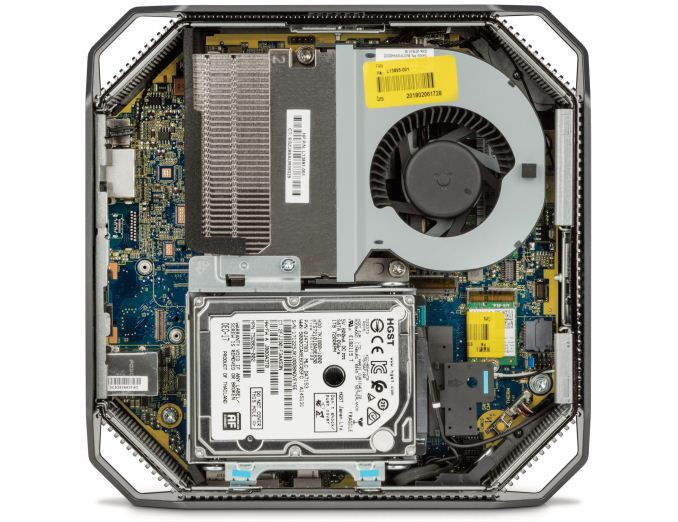
As for memory and storage, the HP Z2 Mini G4 has two SO-DIMM slots supporting up to 32 GB of DDR4-2667, one M.2 slot compatible with HP’s Z Turbo Drive G2 PCIe SSD (up to 1 TB), and a 2.5-inch bay for a SATA SSD or HDD. For entry-level configurations HP will offer a combination of Intel’s Optane Memory caching SSD as well as HGST’s 1 TB 7200-RPM HDD. Meanwhile, depending on the version and power consumption of exact configurations of the new SFF workstations from HP, the products will come equipped with 135 – 310 W external PSUs.
Moving on to connectivity. The new HP Z2 Mini G4 has one GbE (Intel i219-LM) connector, 802.11ac Wi-Fi with Bluetooth 5.0 combo (enabled by the Intel Wireless-AC 9560 CNVi solution and featuring up to 1.73 Gbps throughput over 160 MHz channels), two or three DisplayPort 1.2 outputs (depending on the model), two USB 3.0 Type-A headers, two USB 3.1 Gen 2 Type-C ports, as well as audio input/output connectors.
Like many other HP workstations, the HP Z2 Mini G4 will support the company’s Sure Start Gen4 and HP’s Sure Run technologies that keep critical processes running even when malware attempts to stop them.HP Z2 Mini G4 Specifications Entry Performance CPU Intel Core i3/i5/i7 8000-series
4/6 coresIntel Xeon E 2100-series
with 4/6 coresPCH Intel C246 Graphics Intel UHD Graphics 630 NVIDIA Quadro P600
NVIDIA Quadro P1000
AMD Radeon Pro WX 4150Memory Two SO-DIMM slots, up to 32 GB of DDR4, ECC supported Storage Up to HP Z Drive Turbo 1 TB PCIe 3.0 x4 with NVMe
Intel's Optane Memory caching SSDs
Up to 1 TB SATA 6 Gbps HDDWi-Fi 802.11ac + BT 5.0 (Intel's Wireless AC-9560) Ethernet Gigabit Ethernet with RJ45 connector (Intel i219-LM) Display Outputs 2 × DisplayPort 1.2 3 × DisplayPort 1.2 Audio 3.5 mm audio in and audio out
+ Built-in speakerUSB 2 × USB 3.0 Type-A (5 Gbps)
2 × USB 3.1 Gen 2 Type-C (10 Gbps)Specials Security latch to close USB ports from access Dimensions 216 × 216 × 58 mm
8.5 × 8.5 × 2.28 inchesPSU (external) 135 W - 310 W external PSUs OS Microsoft Windows 10 Pro or Linux Price $799 Unknown
HP will start selling the fourth-generation Z2 Mini G4 workstations later this month. Entry level models without a discrete GPU will cost starting from $799, higher-end models will naturally be considerably more expensive.
Gallery: HP Unveils Z2 Mini G4 SFF Workstation w/ Six-Core Xeon, Quadro or Radeon Pro dGPUs





Buy HP Z2-G3 Mini Workstation i7-6700 on Amazon.com
Related Reading- HP Z2 Mini G3 Announced: Miniature Professional Workstation with Xeon and Quadro
- HP Updates Z8 Workstations: Up to 56 Cores, 3 TB RAM, 9 PCIe Slots, 1700W
- HP Z4 Workstations Get Xeon W and Core X, 18-Core
- HP Spring 2018 Range: ZBook, ZBook, ZBook
More...
-
07-20-18, 03:15 PM #8402
Anandtech: Western Digital Begins to Sample QLC BiCS4: 1.33 Tbit 96-Layer 3D NAND
Western Digital has started sampling its 96-layer 3D NAND chips featuring QLC architecture that stores four bits per cell. The chip happens to be the world’s highest-capacity 3D NAND device. The company expects to commence volume shipments of this memory chip already this calendar year.
Western Digital’s 96-layer BICS4 3D QLC NAND chip can store up to 1.33 Tb of raw data, or around 166 GB. The IC will be initially used for consumer products Western Digital sells under the SanDisk brand, so think of memory cards (e.g., high-capacity SD and microSD products), USB drives, and some other devices. The manufacturer expects its 3D QLD NAND memory to be used in a variety of applications, including retail, mobile, embedded, client, and enterprise, but does not elaborate on timing at this point.
The 1.33-Tb BICS4 IC is Western Digital’s second-gen 3D QLC NAND device. Last year the company announced its BICS3 64-layer 3D QLC chips featuring a 768 Gb capacity, but it is unclear whether they have ever been used for commercial products. Meanwhile, it is clear that the device was used to learn about 3D QLC behavior in general (i.e., endurance, read errors, retention, etc.)
Western Digital and its manufacturing partner Toshiba started volume production of 96-layer 3D NAND earlier this year. Western Digital confirmed in late May that it had begun volume shipments of its BiCS4 memory to its retail customers, which most probably means that the new 96-layer 3D NAND ICs were used for select SanDisk-branded products. The first BiCS4 products that Western Digital announced were 256 Gb 3D TLC ICs, so it is highly likely that they have been in mass production for some time now.
As it appears, yields of 96-layer 3D NAND have been good enoug,h and things that the company has learned with BiCS3 QLC were substantial, so Western Digital moved right to its top-of-the-range capacity of 1.33 Tb per chip. What is noteworthy is that officially the BiCS4 range was to include both TLC and QLC ICs with capacities ranging from 256 Gb to 1 Tb, so the 1.33 Tb IC is a surprising addition to the lineup which signals Western Digital’s confidence of its technology.
Related Reading- Western Digital Announce BiCS4 3D NAND: 96 Layers, TLC & QLC, Up to 1 Tb per Chip
- Western Digital: 96-Layer 3D NAND Progressing Well, Shipping to Retail Customers
- Western Digital Announces Four Bit Per Cell 64-Layer 3D NAND Flash
- Intel Teases Upcoming QLC SSD For Datacenters
- Samsung Begins Mass Production Of 96L 3D NAND
- We Found a Prototype 4 TB Intel QLC SSD
- Intel QLC NAND Updates: Up to 20TB In 2.5-inch SSD
- Intel And Micron Launch First QLC NAND: Micron 5210 ION Enterprise SATA SSD
More...
-
07-20-18, 03:15 PM #8403
Anandtech: The ASRock Z370 Taichi Motherboard Review: Competitive at $220, Aggressive
The Z370 Taichi, like the X299 Taichi and previous generations, comes fully featured and ready to rock out of the box. Not defined by a naming convention, the Taichi sets out to be a well-rounded board with a lot of features at its price point including three M.2 slots, eight SATA ports, SLI/Crossfire support, as well as dual NICs and Wi-Fi capabilities.
More...
-
07-23-18, 11:18 AM #8404
Anandtech: The Patriot Evlvr Portable Thunderbolt 3 1TB SSD Capsule Review
Phison introduced a reference design for entry-level Thunderbolt 3 SSDs at the 2018 CES. Patriot was one of the first to announce a product based on the reference design - the Patriot Evlvr comes with a PCIe 3.0 x2 NVMe SSD sporting the Phison E8 controller and Toshiba BiCS 3D TLC NAND. An Alpine Ridge Thunderbolt controller bridges the NVMe SSD to a Thunderbolt 3 device port. The PCIe 3.0 x2 link means that the product is not going to set any benchmark records. However, Patriot plans to make it quite wallet-friendly. Read on to find out how the product performs, particularly in the price to performance ratio aspect.
More...
-
07-23-18, 05:49 PM #8405
Anandtech: Toshiba Announces XG6 NVMe SSD With 96L 3D NAND
Toshiba is introducing their first SSD using 96-layer 3D NAND flash memory. The new Toshiba XG6 is an update to their XG5 client NVMe SSD for the OEM market. The new 3D TLC NAND should help reduce costs, and will also allow for significantly higher performance. The XG5's performance wasn't competitive with high-end NVMe drives but was plenty for most purposes, and the XG5 was the first NVMe SSD to offer power efficiency similar to SATA SSDs on a variety of workloads. Toshiba promises similar efficiency from the XG6 in spite of the increased performance.
The Toshiba XG6 is still using the same controller as the XG5, so the improvements are mostly due to the new NAND flash, plus some firmware optimizations. The new 96L 3D TLC supports Toggle NAND 3.0 interface speeds in the 667-800MT/s range compared to the 400-533MT/s speeds used by earlier 3D NAND from Toshiba, so data can be moved between the controller and the NAND more quickly (Toshiba didn't disclose the exact speed used on the XG6). The 96L NAND itself has shorter read and program times than the 64L BiCS3 TLC, so the faster interface won't go to waste. The NAND page size hasn't increased, so there isn't any extra overhead for managing small IO sizes compared to what the XG5 has to cope with. As with the XG5, the XG6 will use a mix of 256Gb and 512Gb TLC dies depending on the drive capacity, so the smaller models won't suffer as much from the reduced level of parallelism that would come from using the largest (and cheapest) die across the entire range.
The XG6 is not intended to be a complete replacement for the XG5-P variant that targets higher capacities and sustained performance, but an XG6-P has not been officially announced. However, the XG6 does support user-configurable overprovisioning using a new standard command from the NVMe 1.3a specification, so it has the potential to deliver better steady-state performance than it will provide out of the box.Toshiba XG6 Specifications Capacity 256GB 512GB 1024GB Controller Toshiba TC58NCP090GSD Form Factor single-sided M.2 2280 Interface, Protocol PCIe 3 x4, NVMe 1.3a NAND Flash Toshiba BiCS4 96-layer 3D TLC Sequential Read (128kB, QD64) up to 3180 MB/s Sequential Write (128kB, QD64) up to 2960 MB/s Random Read (4kB, QD64) up to 355k IOPS Random Write (4kB, QD64) up to 365k IOPS Power Consumption Read 4.2 W Write 4.7 W Idle 3 mW TCG Opal Encryption Optional
The XG6 will be available in versions with and without TCG Opal encryption support. The non-encrypting models still implement the basic TCG Pyrite security specification.
The Toshiba XG6 is currently sampling to OEMs and will be showing up in notebook computers soon, replacing the XG5 over the next few quarters. Toshiba never released a retail version of the XG5, but it seems likely that the XG6 will see a retail version to replace the aging and expensive OCZ RD400, which was based on the XG3 OEM SSD.
More...
-
07-24-18, 08:05 AM #8406
Anandtech: Next-Gen NAS: An Interview with Alex Wang, CEO of Synology America
At AnandTech, we have been following the consumer and SMB NAS market very closely over the last decade. Synology is one of the leading vendors in this space. Similar to others in this market segment, they have also been attempting to grow both vertically by targeting the SME and enterprise space, as well as horizontally by creating products for the wireless routers market. Recently we had the opportunity to sit down and discuss the state of the NAS market, as well as Synology's plans to address its requirements, with Alex Wang, the CEO of Synology America. Synology also gave us some insights into their product pipeline for the rest of the year.
More...
-
07-24-18, 08:05 AM #8407
Anandtech: Ian on the iMore Vector Podcast: Discussing Core i9 and Thermal Throttling
On Monday this week I was invited onto the Vector podcast, one of the popular Apple-focused podcasts, run by iMore’s Rene Ritchie. In the podcast we discuss Intel’s product portfolio relating to Apple’s new MacBook Pro line of products, as well as the issues that come with thermal design limits, decisions in that design, how to benchmark, what benchmarks mean, and how the tools we sometimes use for testing are black boxes. The idea was to shed some light onto the recent reports of the newest MBP devices potentially throttling under various scenarios (Ryan currently has our review unit, and will be digging into this in our coverage).
The Vector podcast is a bit more casual than our usual AnandTech podcasts, focusing more on use cases and markets than the deep technical points I usually make, but it was good fun to speak to Rene and hopefully provide a viewpoint from this side of the fence about OEM decisions, be they Apple, Dell, MSI, or other small device manufacturers. This actually plays a lot into content that Brett and I published several years ago when Intel first released Core M. We might go into the issue a lot deeper in our own podcast at some point in the future.
The Podcast can be found on iTunes or through Overcast.fm.
Related Reading:- Analyzing Intel Core M Performance: How 5Y10 can beat 5Y71 & the OEMs' Dilemma
- Apple Updates MacBook Pro Family for 2018
- Intel Expands 8th Gen Core: Core i9 on Mobile, Iris Plus, Desktop, Chipsets, and vPro
More...
-
07-24-18, 10:21 AM #8408
Anandtech: Intel Begins EOL Plan for Xeon Phi 7200-Series ‘Knights Landing’ Host Proc
Intel has initiated its product discontinuance plan for its Xeon Phi 7200-series processors codenamed Knights Landing (KNL). The said CPUs are used primarily for HPC applications, including supercomputers. As it appears, demand for these chips is not exactly great, which is why Intel does not see any reasons to keep producing them. At the same time, the company will keep offering its codenamed Knights Mill (KNM) solutions for Deep Learning.
Intel announced product discontinuance plan for the Xeon Phi 7210, 7210F, 7230, 7230F, 7250, 7250F, 7290, and 7290F processors on Monday. The process of their phasing out is not going to take long. The company’s customers are told to place their final orders on these CPUs by August 31, 2018. Meanwhile, the final products will be delivered by July 19, 2019.
As usual, Intel explained that “market demand for the products has shifted to other Intel products,” indicating that its Xeon Phi 7200-series processors in LGA3647-1 form-factor might not exactly popular among target customers in the technical computing space. The said processors feature from 64 to 72 HPC-enhanced Atom Silvermont cores that process up to four threads of code simultaneously and are outfitted with 16 GB of high-bandwidth MCDRAM memory. As for throughput, socketed Xeon Phi KNL processors offer 3-3.4 TFLOPS of double precision floating point (FP64) performance.
Intel announced the EOL plan for HPC-oriented many-core Xeon Phi 7200-series “Knights Landing” CPUs about 11 months after it decided not to release its Xeon Phi 7200-series coprocessor cards. The latter only offered performance of up to 3 TFLOPS FP64 and featured considerably more limited I/O options than their socketed counterparts: they only had 16 PCIe 3.0 lanes (vs. 36 lanes on CPUs) and they did not support Intel’s OmniPath fabric (unlike the Xeon Phi 7200F-series CPUs) that is particularly useful for supercomputer deployments. Meanwhile, since socketed Knights Landing CPUs do not support multi-processor configurations, the coprocessors cards could be used for density, which is crucially important for HPC applications. As it appears, Intel first decided to EOL KNL cards and eliminate their density advantage, but now it decided to discontinue even the processors, possibly because of low interest from potential customers.
The discontinuance of Intel’s Xeon Phi 7200-series Knights Landing CPUs does not mean the end of the road for the product family in general. Intel will continue to offer its Xeon Phi 7235/7285/7295 “Knights Mill” CPUs optimized for Deep Learning applications, but featuring a lot of similarities with the Knights Landing. Nonetheless, with the cancellation of Knights Hill and obvious problems with Intel’s 10 nm process technology, it looks like the company will not have a competitive Xeon Phi product for the HPC market for quite some time.AVX-512 Support Propogation by Various Intel CPUs Xeon, Core X General Xeon Phi Skylake-SP AVX512BW
AVX512DQ
AVX512VLAVX512F
AVX512CDAVX512ER
AVX512PFKnights Landing Cannon Lake AVX512VBMI
AVX512IFMAAVX512_4FMAPS
AVX512_4VNNIWKnights Mill Ice Lake AVX512_VNNI
AVX512_VBMI2
AVX512_BITALG
AVX512+VAES
AVX512+GFNI
AVX512+VPCLMULQDQAVX512_VPOPCNTDQ Source: Intel Architecture Instruction Set Extensions and Future Features Programming Reference (pages 12 and 13)
Bold: Supported by Knights Landing
Related Reading- Intel Discontinues Xeon Phi 7200-Series ‘Knights Landing’ Coprocessor Cards
- Intel’s "Knights Landing" Xeon Phi Coprocessor Detailed
- Intel @ SC15: Launching Xeon Phi “Knights Landing” & Omni-Path Architecture
- SuperComputing 15: Intel’s Knights Landing / Xeon Phi Silicon on Display
- Intel Lists Knights Mill Xeon Phi on ARK: Up to 72 cores at 320W with QFMA and VNNI
- Intel Announces Knights Mill: A Xeon Phi For Deep Learning
More...
-
07-25-18, 07:57 AM #8409
Anandtech: Intel Officially Launches Bean Canyon NUCs with Coffee Lake-U Processors
Intel's Bean Canyon NUCs have been subject to a number of leaks, notably from FanlessTech. However Intel has finally made things official with a detailed technical product manual for all the members of the Bean Canyon NUC family. From an I/O perspective, the Bean Canyon NUCs look very similar to the Baby Canyon NUCs. However, the internals have gone in for a significant revamp, thanks to the Coffee Lake processors (CFL-U) inside. The updates include:
- 28W TDP processors across all SKUs, with true quad-core / octa-thread options
- Iris Plus Graphics 655 with 128MB eDRAM across all SKUs
- Intel Wireless-AC 9560 with Bluetooth 5.0 WLAN module
- USB 3.1 Gen 2 (10 Gbps) support on all external Type-A ports
While most of the Baby Canyon NUCs came with a 15W TDP processor - either in a "2+2" or "2+3e" configuration - all the Bean Canyon models (NUC8BE) sport 28W TDP processors (that can be configured to run with a lower TDP of 20W, if needed). The 28W TDP allows all the models to come with Iris Plus Graphics 655 with 128MB of eDRAM as the integrated GPU. This makes "2+3e" CPUs the new baseline, while even more powerful "4+3e" CPUs are now an option.
Since these are U-series processors, the PCH is on-package with the rest of the CPU. The move to the Cannon Point-LP integrated PCH allows for four USB 3.1 Gen 2 ports that are present as Type-A ports in the front and rear of the chassis. The CFL-U come with the new Integrated Connectivity feature (CNVi), where the Wi-Fi and Bluetooth MAC and other functional blocks are put inside the processor. The CRF (companion RF) module completes the Wireless-AC 9560 by implementing the signal processing, RF, and analog functions.
The Intel Wireless-AC 9560 is a significant upgrade over the Wireless-AC 8265 in the Kaby Lake NUCs. It comes with Wave 2 features, including support for 160 MHz channels and downlink MU-MIMO. The 2x2 WLAN module is theoretically capable of 1.73 Gbps bandwidth. It also integrates dual-mode Bluetooth 5 support.
Intel continues to use a LSPCon on board to convert the Display Port 1.2 output of the processor to a HDMI 2.0 port with HDCP 2.2. Unfortunately, stereoscopic 3D will not be supported. The good news is that the Thunderbolt 3 USB Type-C port on all the models will also support 4Kp60 displays with HDCP 2.2. All versions of the Bean Canyon will support Thunderbolt 3 (unlike the Core i3 version of the KBL-U Baby Canyon that restricted the Alpine Ridge Type-C port to USB 3.1 Gen 2 only in the firmware).Intel Bean Canyon NUC PCs (Non-Optane SKUs) NUC8i7BEH NUC8i5BEH NUC8i5BEK NUC8i3BEH NUC8i3BEK CPU Core i7-8559U
4C/8T
2.7 (4.5) GHz
28 W TDPCore i5-8259U
4C/8T
2.3 (3.8) GHz
28 W TDPCore i3-8109U
2C/4T
3.0 (3.6) GHz
28 W TDPGraphics Intel Iris Plus Graphics 655 PCH Intel Cannon Point-LP for Coffee Lake-U Memory Two SO-DIMM slots, up to 32 GB of DDR4-2400 2.5" bay 1x2.5"/9.5mm bay, SATA3 None 1x2.5"/9.5 mm bay, SATA3 None M.2 Slot Up to M.2-2280 SSD with SATA3 or PCIe 3.0 x4 interface Wi-Fi/BT Soldered-down Intel Wireless-AC 9560(802.11ac 2x2 + BT 5.0) with WiDi support Ethernet Intel I219V Gigabit Ethernet controller Display Outputs DisplayPort 1.2 via USB-C connector
HDMI 2.0Audio 3.5 mm TRRS audio jack
7.1 channel audio output via HDMI or DPThunderbolt
& USB-C1x Thunderbolt 3 Type-C (40 Gbps) (USB 3.1 Gen 2 and Display Port functionality included) USB 4 USB 3.1 Gen 2 Type-A (10 Gbps), one with charging Other I/O MicroSDXC card reader with UHS-I support
One infrared receiverSize (mm) 115 × 111 × 51 115 × 111 × 31 115 × 111 × 51 115 × 111 × 31 PSU External, 65 W
Similar to the previous NUCs, Intel plans to sell both kit (NUC8iXBEK / NUC8iXBEH) and board versions (NUC8iXBEB) of the different configurations. Note that the BEK does not support a 2.5" drive, while the BEH SKUs do. System builders using the BEB SKUs can opt to operate the processor in the cTDP down (20W) mode if adequate cooling is not available. Intel also plans to offer pre-built systems with Optane, as described below.
Retail availability is expected to be in early August. Pricing details are yet to be made available.
Gallery: Intel Officially Launches Bean Canyon NUCs with Coffee Lake-U Processors


More...
-
07-25-18, 09:40 AM #8410
Anandtech: Synology 2018 NAS and Wi-Fi Lineup Sneak Peek
Yesterday we published an interview with Alex Wang, CEO of Synology America, and as part of that interview we were able to get a sneak peak into some of the new NAS and Wi-Fi products that Synology is planning to launch through to the end of 2018.
Wi-Fi
The company plans to introduce a follow-up to the RT2600ac released earlier this year. The new MR2200ac comes with mesh features. Similar to other mesh routers from the top tier vendors, the MR2200ac sports the Qualcomm IPQ4019 SoC with integrated dual-band Wi-Fi. The additional PCIe interface enables Synology to add a second 5 GHz radio, turning the MR2200ac into a tri-band router. Like the Netgear Orbi, the MR2200ac plans to use the second 5 GHz radio for backhaul purposes. Synology has built up on Qualcomm's Wi-Fi SON features to enable the MR2200ac to mesh with the RT2600ac (also Qualcomm-based). The RT1900ac, unfortunately, will not be compatible for meshing purposes. Synology is planning to bring in features such as easy parental control and threat prevention (antivirus / malware scanning etc.) to make their routers stand out in the crowded market.
Business
In terms of subscription-based value additions for business users, Synology is launching Active Backup for Office 365 as part of their Active Backup suite. The Active Backup for Business service includes backup of virtual machines, instant recovery, full disk image backups with dedupe etc.
Storage
Being primarily focused on storage solutions, Synology will naturally offer several new NAS aimed at customers with different requirements later this year. In total there will be four new NAS products: two in a desktop form-factor and two in a rackmount form-factor. All four machines will support Synology’s typical NAS software with well-known capabilities.
- DS619slim using an Intel Celeron J3355 and sporting 6x 2.5" drive bays
- DS2419+ using the Intel C3538 Denverton processor and providing 12 bays in a desktop form factor.
- RS1619xs+ using a Xeon CPU in a 1U form-factor and providing 4 bays
- RS1219+ using the older Rangeley family CPU with 8 bays in a short-depth 2U form factor
The most basic of Synology’s upcoming NAS devices is the DS619slim aimed at small office/home office markets. The DS619slim is based on Intel’s dual-core Celeron J3355 SoC (Apollo Lake) outfitted with 2 GB – 8 GB of RAM. The NAS has six 2.5-inch bays for HDDs or SSDs, but it does not look that it supports caching on an SSD for additional performance (at least today’s entry-level NAS products from Synology do not support this feature). Meanwhile, since RAID stripe mode will be supported, we are still talking about read/write performance of about ~500 MB/s even with hard drives. As for network connectivity, the DS619slim will have two GbE ports.
A more powerful NAS that Synology will have later this year is the DS2419+. This NAS is powered by Intel’s quad-core Atom C3538 SoC (Denverton), is equipped with 4 – 32 GB of RAM as well as four GbE network connectors. The DS2419+ will have 12 bays and will support a PCIe slot for a caching M.2 SSD or a 10 GbE NIC.
Moving on to rackmount NAS for businesses that require a higher performance and/or more storage space. First up is the 1U RS1619xs+ NAS based on Intel’s quad-core Xeon processor clocked at 2.2 GHz and equipped with 8 – 64 GB of DDR4 memory with ECC. This NAS has four bays and two M.2. SSD slots for high-performance caching drives. By default, the RS1619xs+ will be equipped with four GbE LAN ports, but optionally Synology may install two 10 GbE NICs for those who have appropriate networks.
For customers who need a higher capacity, Synology will offer its 2U RS1219+ NAS featuring eight bays and powered by Intel’s quad-core Atom SoC and 2 – 16 GB of DDR3 memory. The machine will feature 4 GbE controllers by default or two optional 10 GbE ports for those who can use them.
Pricing of the new NAS units will be announced when Synology starts to offer them commercially.
Related ReadingSynology's NAS Due in 2H 2018 DS619slim DS2419+ RS1619xs+ RS1219+ Form-Factor Desktop 1U 2U SoC Dual-Core
Celeron J3355Quad-Core
Atom C3538Quad-Core Xeon Quad-Core Atom RAM 2 - 8 GB 4 - 32 GB 8 - 64 GB 2 - 16 GB Number of Bays 6 12 4 8 Caching SSDs - M.2/NVMe
(or 10GbE)2 × M.2 NVMe SSDs ? Network Connectivity 2 × GbE 4 × GbE
or 1 × 10 GbE4 × GbE
or 2 × 10 GbE- Next-Gen NAS: An Interview with Alex Wang, CEO of Synology America
- Synology Introduces DiskStation DS1618+ with Intel Denverton
- Synology Launches Major Package Updates and Demonstrates Recent NAS Models at CES 2018
- Synology at CES 2017 - RT2600ac Wi-Fi Router, DSM Value Additions, and New Business NAS Units
- Semi-Critical Intel Atom C2000 SoC Flaw Discovered, Hardware Fix Required
Buy Synology 6 Bay NAS DiskStation - DS1618+ on Amazon.com
More...
Thread Information
Users Browsing this Thread
There are currently 8 users browsing this thread. (0 members and 8 guests)




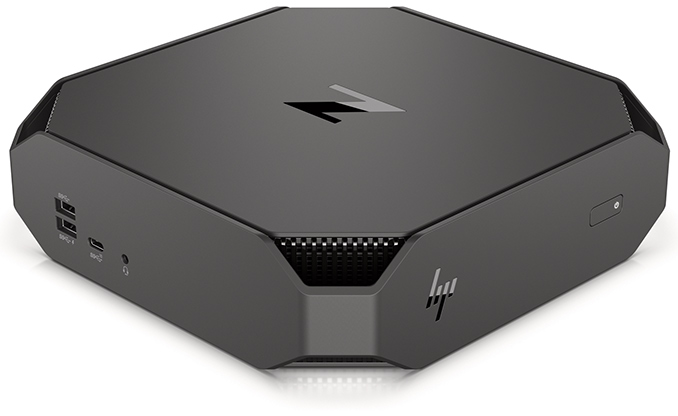

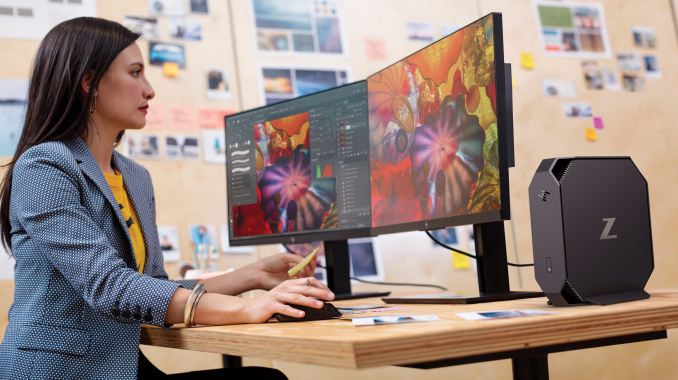

 Quote
Quote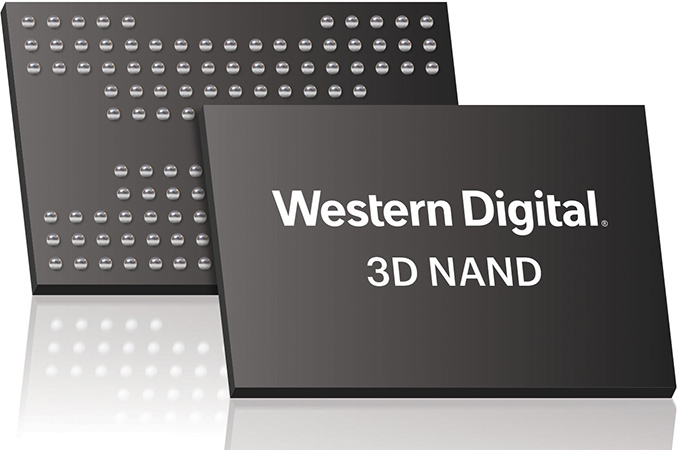
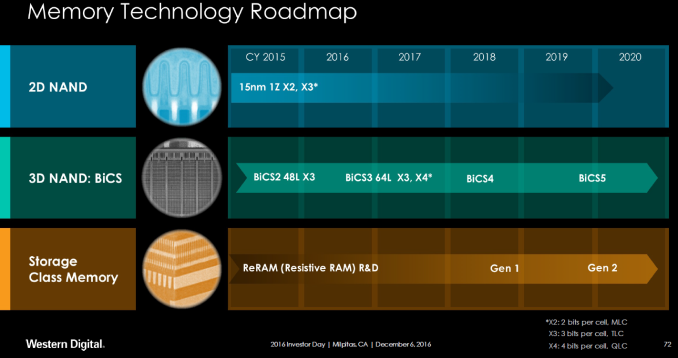
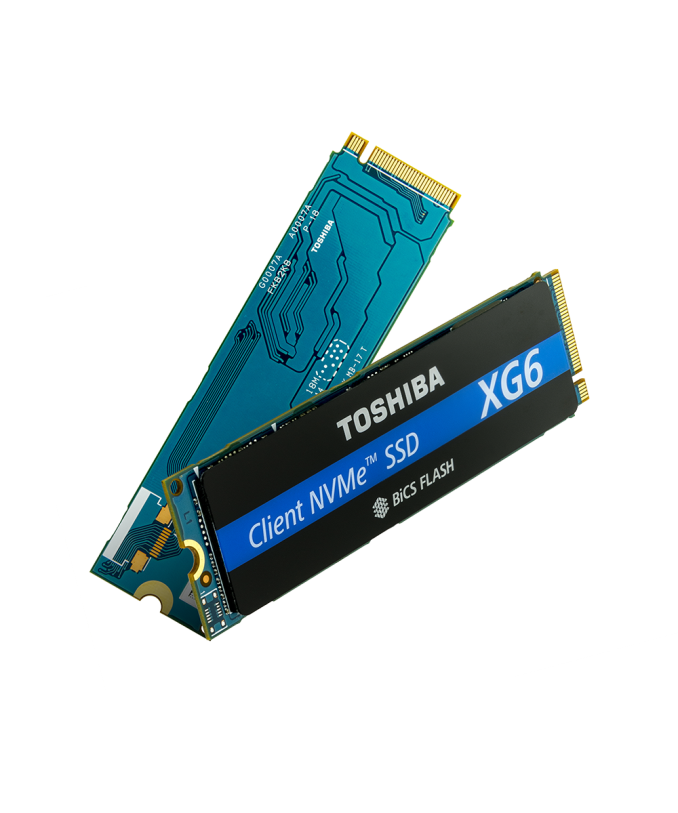



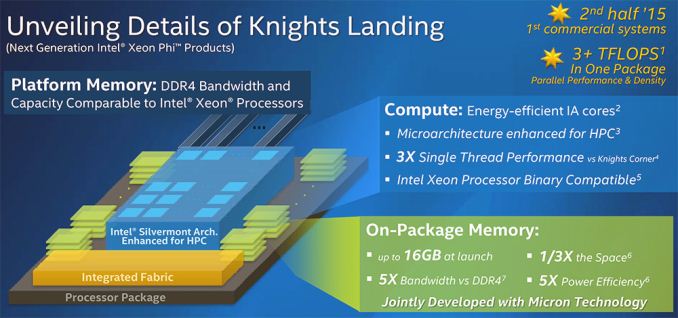


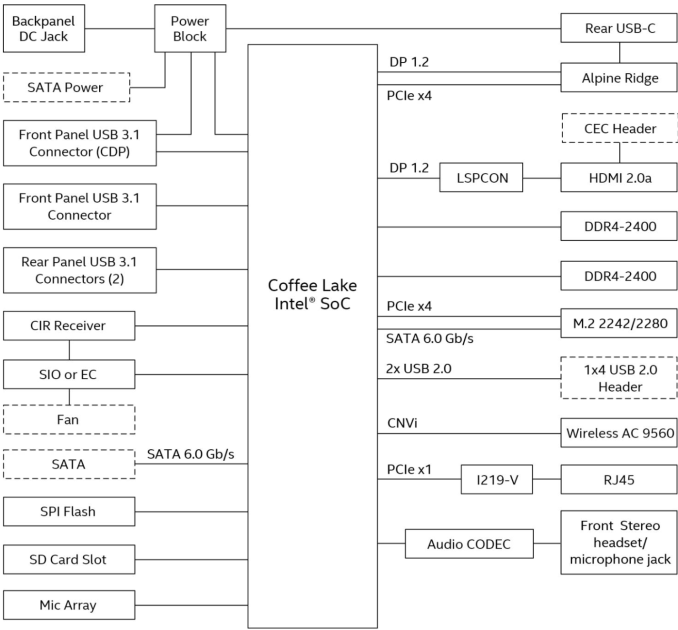
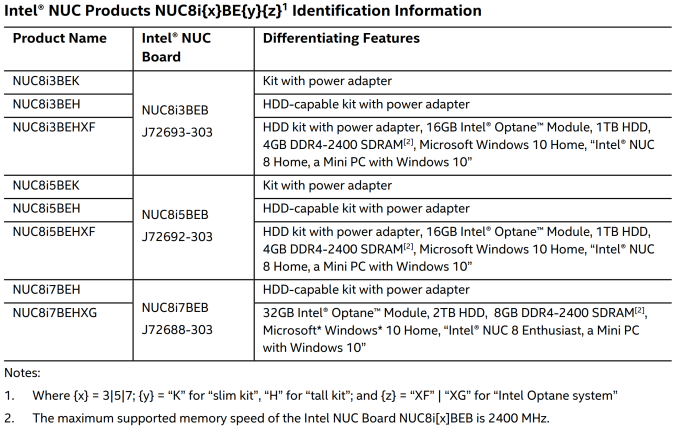

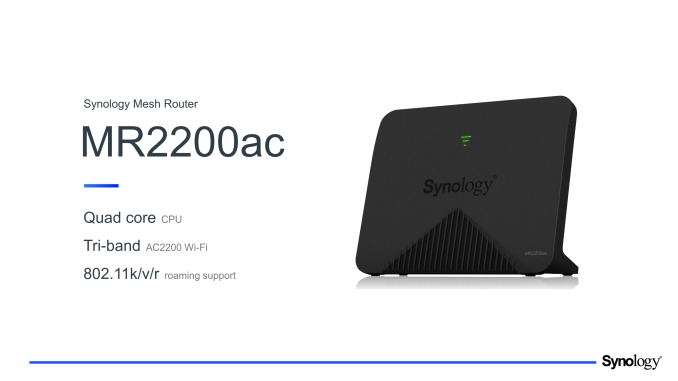
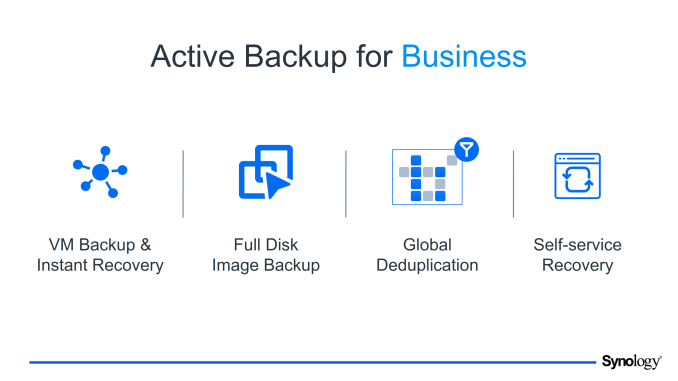
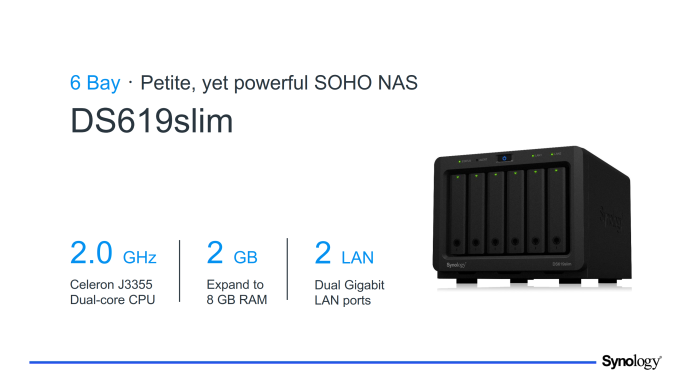


















Bookmarks